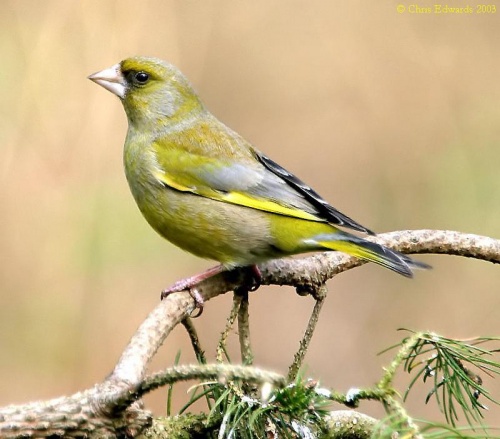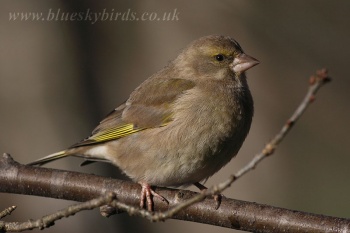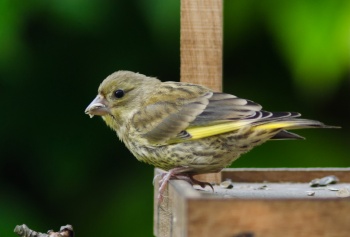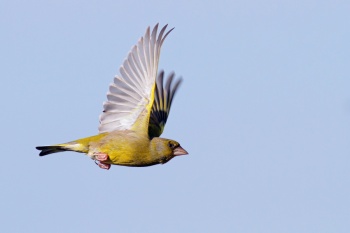- Chloris chloris
Carduelis chloris
Identification
14-16cm
Male varies from bright olive green in summer to a greyer shade of green after moult
Female duller and browner above.
Both have brilliant yellow wing panel.
Distribution
Europe, north Africa and south west Asia.
Introduced to New Zealand.
Taxonomy
Subspecies
There are 6 subspecies[1]:
- C. c. chloris:
- British Isles, northern Europe, Corsica and Sardinia; winters to southern Europe
- C. c. voousi:
- C. c. vanmarli:
- Lowlands of northern Morocco
- C. c. aurantiiventris:
- C. c. chlorotica:
- C. c. turkestanica:
- Crimea to Caucasus, northern Iran and Turkmenistan; winters to southern Iran
A further 4 subspecies, madaraszi, harrisoni, muehlei and bilkevitschi, are not recognised by all authorities[1].
Formerly placed in genus Carduelis.
Habitat
Woodland edges, farmland hedges and gardens and parks.
Behaviour
Can be aggressive when competing for food, chasing off other smaller birds.
Diet
The diet includes seeds. Regularly visiting garden bird feeders.
Breeding
April to August. Twigs form the base of the nest, upon which is made a bowl of moss lined with grass, rootlets, feathers and wool and is located in a bush or tree. The clutch consists of 4-5 pale blue eggs with reddish-brown spots. Incubation takes about 2 weeks, the chicks fledging after 13-16 days. There may be up to 3 broods in the season.
Vocalisation
References
- Clements, J. F., T. S. Schulenberg, M. J. Iliff, B.L. Sullivan, C. L. Wood, and D. Roberson. 2012. The eBird/Clements Checklist of Birds of the World. 6th ed., with updates to October 2012. Ithaca: Cornell Univ. Press. ISBN 978-0801445019. Spreadsheet available at http://www.birds.cornell.edu/clementschecklist/downloadable-clements-checklist
- Bird Watching
Recommended Citation
- BirdForum Opus contributors. (2025) European Greenfinch. In: BirdForum, the forum for wild birds and birding. Retrieved 30 April 2025 from https://www.birdforum.net/opus/European_Greenfinch
External Links
GSearch checked for 2020 platform.1







